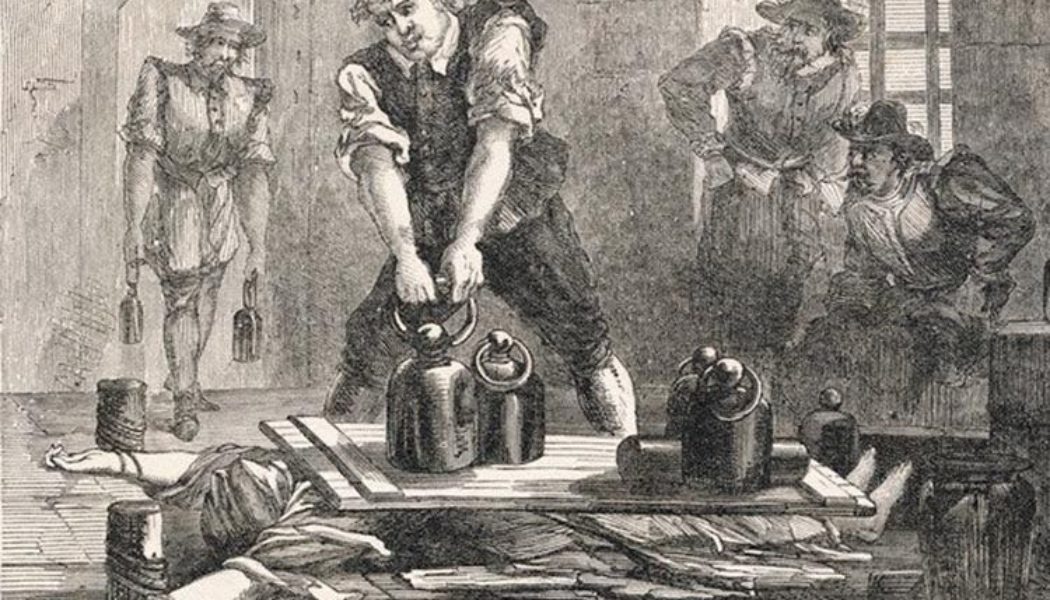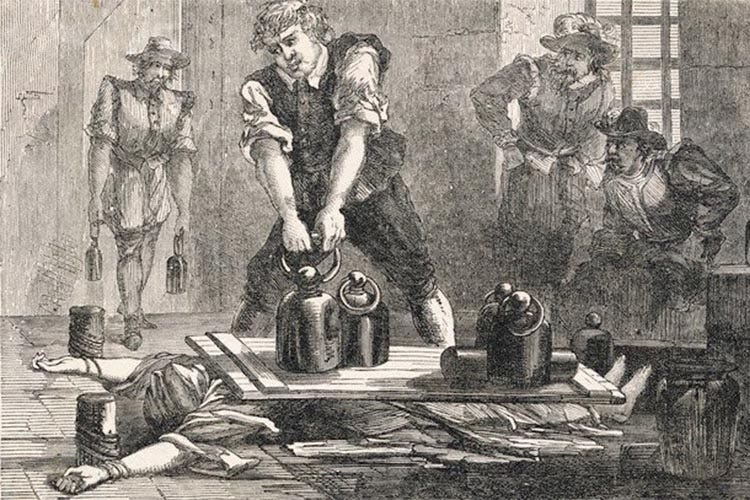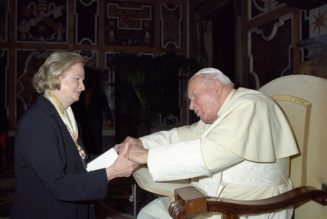Happy Friday friends,
And a very happy feast of St. Margaret Clitherow to you all, whether you celebrate or not — because everyone should.
For those of you unfamiliar with the Pearl of York, a martyr for the faith under the brutal reign of Bloody Queen Bess, her’s is a beautiful story.
She converted to Catholicism as an adult, already married, and was imprisoned several times for refusing to attend Protestant services. She also hid priests in her house in the Shambles, the chaotically labyrinthine district of York which gave its name to total messes everywhere.
Ironically, the place is now so thoroughly preserved it’s like going to a theme park, but you can visit St. Margaret’s house — which I heartily recommend.
Anyway, Margaret was eventually caught by the priest-finders but, in order to spare her children (Catholics) and husband (not a Catholic) violent interrogation during her trial and inevitable destitution after her conviction, she blocked the trial from ever taking place — she simply refused to enter a plea, so procedurally it couldn’t begin.
In line with English legal practice at the time, Margaret was laid atop sharp stones under a wooden platform, upon which weights were piled until she pled either guilty or not guilty, or she was crushed to death. She chose death.
Of course, had she pled “not guilty” I wouldn’t have fancied her chances for mounting a successful defense — she could hardly deny being Catholic, and they had found the priest holes in her house. And a guilty plea would have meant (equally) certain execution.
But by refusing to plead one way or another, she couldn’t be convicted, so the family home and assets couldn’t be seized, and her children and husband were spared (potentially self-incriminating) interrogation under oath during her trial.
I cannot say for sure if I admire most her witness of faith, her maternal concern for her family, or her faultless command of procedural law — but the combination of all three is surely saintly.
Her story is also, by the way, historically instructive. The absurd myth of the Spanish Inquisition as a bloodsoaked torture fest, with dank dungeons full of prelates with red hot pokers, is and always has been an Elizabethan invention and naked exercise in projection by Bloody Bess’s royal court.
St. Margaret’s treatment under English law was neither especially uncommon nor illegal; no such conduct existed in the canonical system.
How’s that for unexpected?
Anyway, here’s the news.
The News
We broke the story this week that well-known media figure Fr. Thomas Rosica has been accused of sexually assaulting a younger priest during the lead up to the Church’s 2002 World Youth Day in Toronto, Canada.
That relationship “allowed Rosica an opportunity to be alone with the Plaintiff and to exert total control over him, prey upon him and sexually abuse him,” the lawsuit charges.
Rosica was the principal organizer of the 2002 World Youth Day, a Vatican advisor and media attaché, and was a fixture in Catholic media and television for nearly two decades, before his prominence was stalled by 2019 reports of widespread plagiarism.
The priest was also a high-profile participant in the Vatican’s 2019 global abuse summit, convened by Pope Francis, where he urged that the problem of clerical sexual abuse not be “ignored.”
He previously served as an official Vatican spinner for the 2015 Synod on the Family, claiming during a press conference that “there is a sexual nature to the Eucharist” which needed to be “rooted in human sexuality” which “helps us even better to appreciate the sacrament of the Eucharist.”
As we reported, in March this year Rosica’s religious order removed his faculties for priestly ministry but, despite that, Rosica was listed as the facilitator of a “Walking with Francis” retreat at a Jesuit-owned retreat in July, and advertised to lead another such retreat in January.
After we published our story, the Canadian Jesuit province released a statement saying they “remain steadfast in our commitment to the safety and protection of minors and vulnerable adults” and their “rigorous safety protocols are applied uniformly to all individuals, including visiting clergy and collaborators.”
“In response to the recent civil lawsuit involving Father Thomas Rosica, CSB and in accordance with our established procedures, he can no longer be associated with any ministry connected to our Jesuit apostolates until these legal and ecclesial matters are resolved,” the Jesuits said.
You can read the whole report here (and only here).
—
Over the last six years, Daniel Ortega’s government has orchestrated a campaign of harassment, mass arrest, imprisonment, and exile of Nicaraguan clergy, and overseen the near wholesale confiscation of Church property and assets.
How the heck does that happen? And who are the Nicaraguan priests backing the Church’s oppressor? And why would they do that?
Read this analysis to find out.
—
The Scottish Archdiocese of St. Andrews & Edinburgh drew attention this month, when it highlighted a recent ecumenical exchange, with a Catholic priest and Church of Scotland minister taking turns to preach to each other’s Sunday congregations.
It’s an interesting story, and something of an historic gesture in the local Church, but a few people asked us about where the whole thing fits into canon law and ecumenism. Basically, who is allowed to preach at Mass — and what is “preaching” technically, anyway?
—
Chinese state authorities recognized a 95-year old underground bishop as the legitimate head of his diocese this week.
Bishop Melchior Shi Hongzhen has led the Diocese of Tianjin since 2019 — having previously been coadjutor of the diocese since 1982. He is believed to be the first bishop government authorities have recognized who has not formally joined the state-sponsored Chinese Patriotic Catholic Association.
In an analysis earlier this week, I took a look at why that could be very significant for the Chinese underground Church, in that it may signal new, theologically ecclesiologically acceptable terms for clergy to accept state recognition after years of being told they must acknowledge Communist Party supremacy in Church affairs.
I think this is one of those “tip of an iceberg” stories, and there’s a lot going on under the surface here. Read the whole thing.
Why, it matters
The situation of Bishop Shi this week is fascinating to me.
So, apart from what we already covered this week, I want to zoom out for a second and consider a few other angles, because I am convinced this story is one of those events the full significance of which we aren’t close to getting our heads around yet.
For sure, the Vatican-China deal is up for renewal in a few weeks. And, for sure, Rome needs all the data points it can marshall to suggest the deal as being implemented is anything shy of a complete shambles. And, most likely, China has no particular reason not to throw the Vatican some easy good PR if it doesn’t cost the CCP anything.
So a reflexive analysis would read that the state recognition of a 95-year old underground bishop is just a cheap and cheerful stunt for a quick and easy headline all around before the deal is reupped.
Go a little deeper, and we have to ask what the succession plan is for the Diocese of Tianjin? It has been widely rumored, both in Rome and among senior Chinese clergy, that the Vatican was pushing hard for a local underground priest to be accepted as Shi’s successor, but that no agreement could be reached with the government.
As compromises go, recognizing a nonagenarian is pretty thin gruel for all sides, and hardly defers the need for an eventual candidate by very long. So, looking ahead, does bringing Shi into state-sponsored acceptability clear the way for local underground Catholics and clergy to acknowledge an eventual CPCA successor? Maybe.
Or, maybe, more of his own underground priests will opt to take the same deal Shi was given, if it is on offer, and suddenly become viable future bishops.
And what do 12,000 local underground Catholics make of all this? Speaking to friends in China, the sense is that the underground faithful normally take a cynical view of priests and bishops who sign up with the state — viewing them as giving in and taking a quiet life of relative comfort and security.
But, I was told, while there is a suspicion amongst underground Chinese Catholics that clerics conform out of a kind of veniality, this isn’t true of Shi, who has spent decades dealing with state harassment and persecution and offering unflinching witness to the faith. At 95, no one thinks he’s after a quiet life now.
So why did he agree to state recognition at all? As I wrote in my analysis, it seems clear he was offered a formula of patriotic loyalty which isn’t explicitly contrary to the faith, but Shi strikes no one I have talked to as a man who was looking for a compromise.
Why Bishop Shi personally agreed to state recognition seems to me the most important question in all of this, since I suspect the answer would tell us much about the underground Church, the disposition of state officials to it, and the extent to which both sides consider the Vatican to have any real practical impact on what happens next for the local Church.
This is a lot to load on to what looks like a fairly minor event, I know. But that’s where the story is.
Canned heat
I like Italy, I should say that upfront. Some of my best friends are Italians. I had Italians at my wedding.
Have they managed to organize a stable and reasonably efficient government since the fall of the Western Empire? No. But across the cultural board they have pretty much bossed the game for centuries, punching way above their weight when it comes to art, architecture, music, literature, and just generally living well.
As I say, I am a fan. But I think we can all admit that, as a people, Italians have a tendency to take themselves a little too seriously, sometimes. And they can be a little defensive about the things at which they excel — nowhere more so than with their food.
It has always struck me as ironic that a people known for their casual indifference to norms in general — financial regulations, tax laws, road signs — suddenly become downright authoritarian in the kitchen.
Anyone who has any familiarity with that mafia-like “non-proft” which polices and shakes down pizza parlors across Napoli in the name of “authenticity” knows what I am talking about. As does anyone who has ever hosted an Italian for dinner and made the mistake of letting them in the kitchen while you prepare the pasta course — as I have, to my considerable chagrin.
I’m not saying that Italians don’t have good reason to be proud of their cuisine. It is inarguably world beating; it is certainly superior to the French. But the histrionics which ensue if you take even the littlest liberty with it seem to me to bespeak a misplaced insecurity.
In a perfect world, I think Italians should celebrate, not denigrate, the cross pollination of Italian artisanal tradition with American immigrant culture’s iconoclasm. And if they rightly think they do it better, they should be secure in that knowledge, instead of taking everything as an assault on their national dignity.
Case in point, Chicago style deep dish is, when compared to an “authentic” Neapolitan pizza, a weapons-grade nuclear mutation. But it isn’t meant to be a challenge to the original, or even an attempted improvement. It’s just it’s own thing, with very identifiable albeit distant roots in something else.
Rock’n’roll doesn’t happen without the blues, but no reasonable person thinks the existence of Led Zeppelin is an offense against the music of Blind Willie Johnson.
That said, there is a line between inspiration and insult, and I accept it can sometimes be hard to see.
This week, for example, I read that Heinz is launching spaghetti carbonara in a can.
I can understand how, for many Italians, Romans in particular, this will be received as an act of war. But allow me to defend it, on philosophical grounds if not gastronomic ones.
I cede from the beginning that no one should eat this. Ever. Doing so would be an act of existential despair and self loathing warranting medical intervention. Pets eat dinner from cans, not people.
That being said, I would like to stake a claim for an American company’s RIGHT to do this. It could even be argued that this is more authentic than the “traditional” Roman version. Hear me out.
Even the most chauvinistic Italian acknowledges that carbonara was a dish created during the Second World War for Americans, using GI rations supplied to local cucinares with a request for, basically, a bacon and eggs breakfast pasta.
All this purists’ voodoo about only guanciale, not pancetta, being acceptable to use, and the affected horror at cream even being in the kitchen while carbonara is being made is retconned mythmaking. As it happens, it all makes for a better dish — but that’s beside the point.
Carbonara was, strictly speaking, conceived by Americans who simply asked Italians to make it for them. Those soldiers subcontracted out the production, but the intellectual property is as American as blue jeans — another cultural export the Italians have appropriated and adapted to a high level. Just as we have done with pizza.
Arguably, the most “authentic” carbonara is the one that appeals most to the most basic American palate, and satisfies the basest of uncultured Yankee appetites, since that’s what its creators presumably intended it for.
Seen from this angle, Heinz isn’t debasing Italian heritage with its carbonara in a can. The company is instead reclaiming a great American invention, and restoring it to its originally intended form.
While I would never eat this abomination myself, I will — as an act of proud patriotism — keep a can in my pantry, ready to serve up to a particular Italian priest of my acquaintance, along with a history lesson, in the near future.
That’ll teach him to lecture me about salting the water.
See you next week,
Ed. Condon
Editor
The Pillar
Comments 38
Services Marketplace – Listings, Bookings & Reviews











